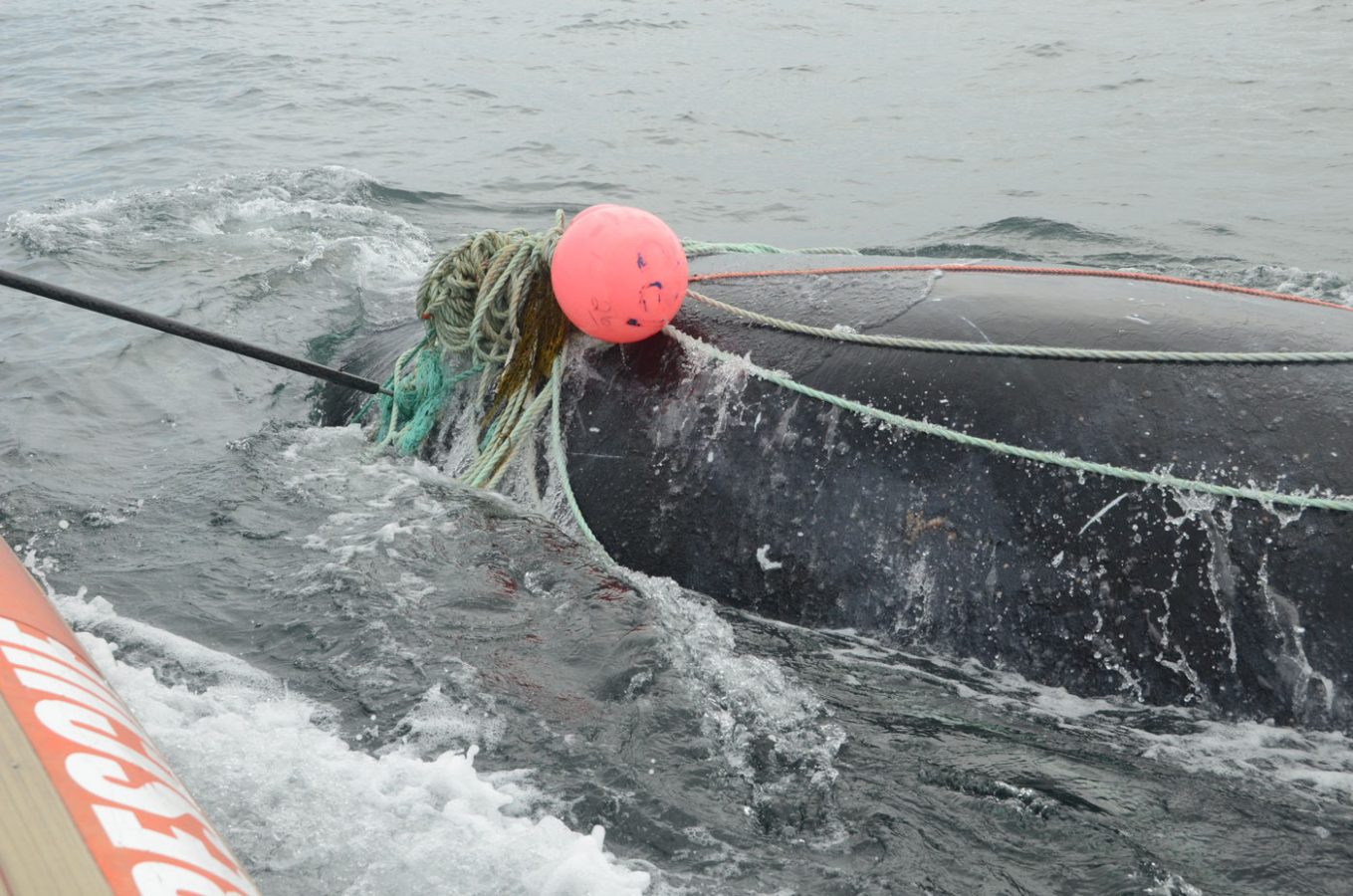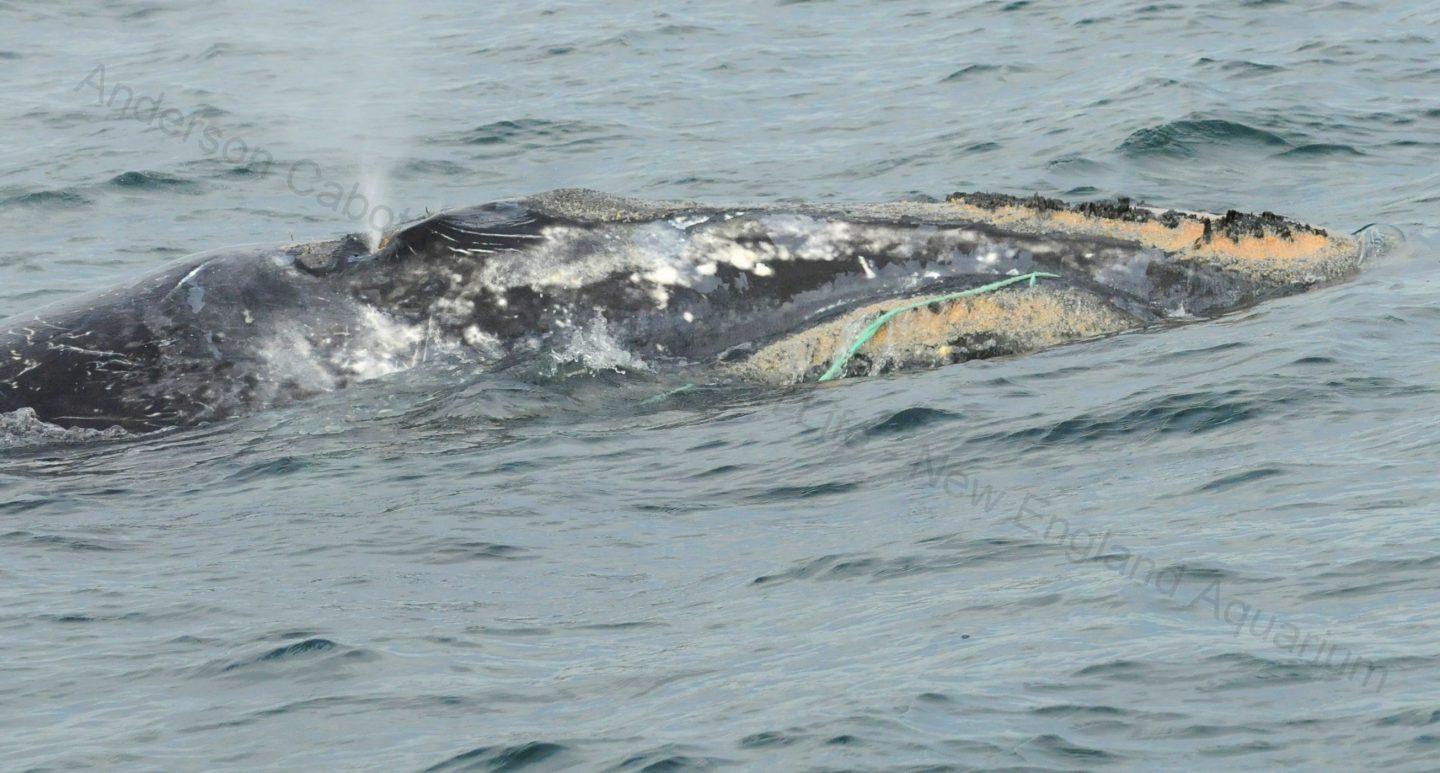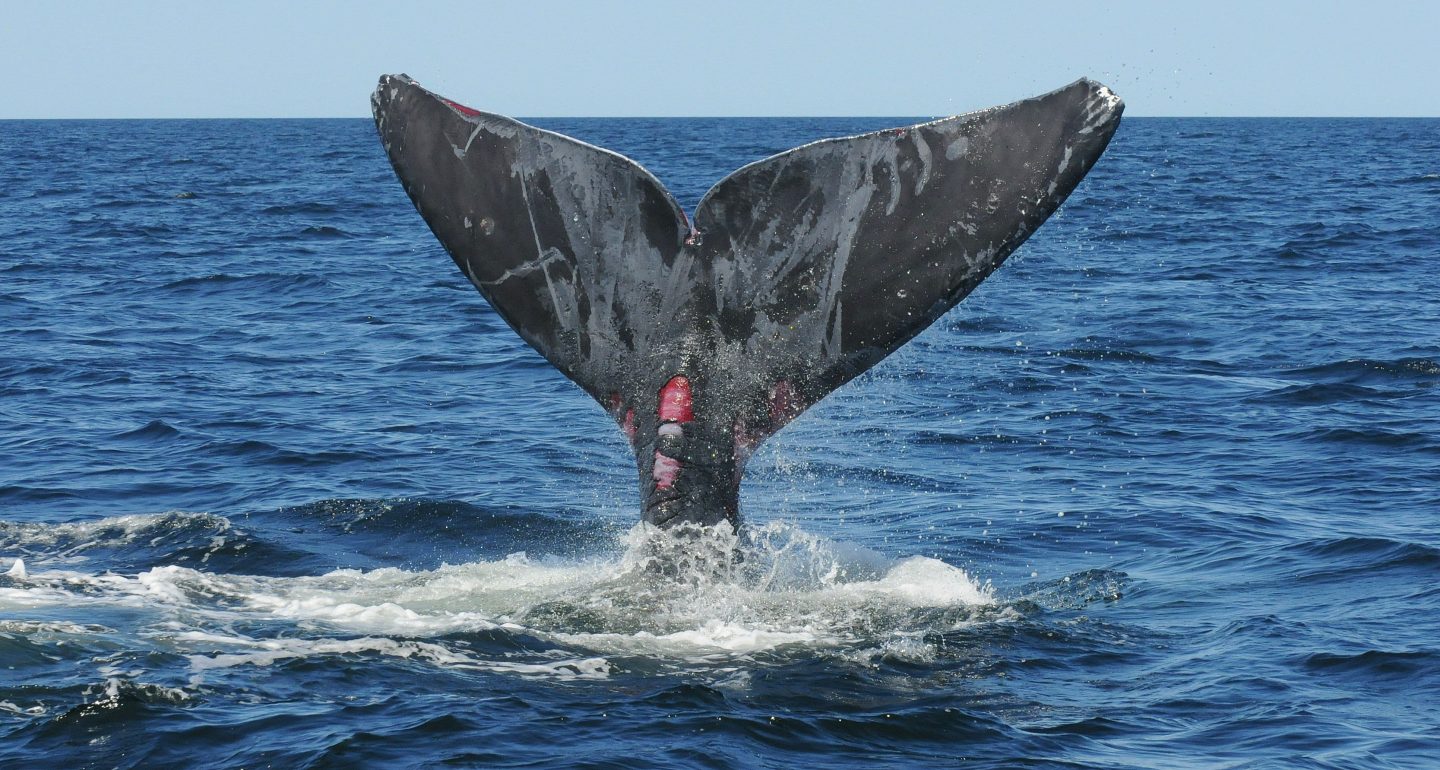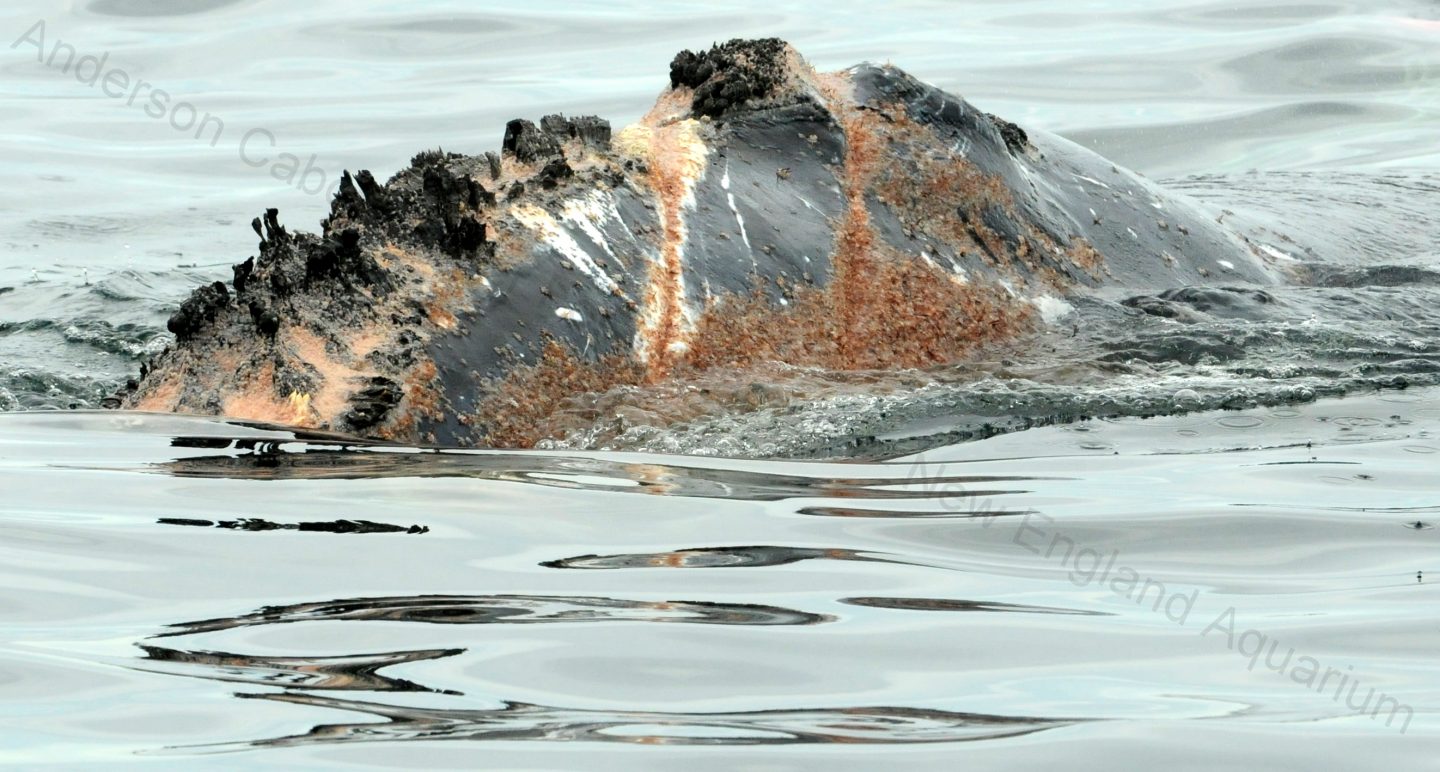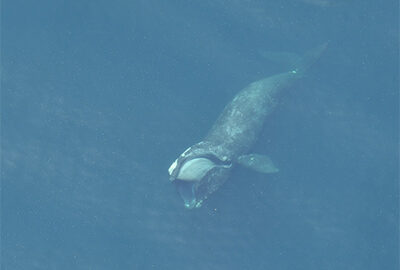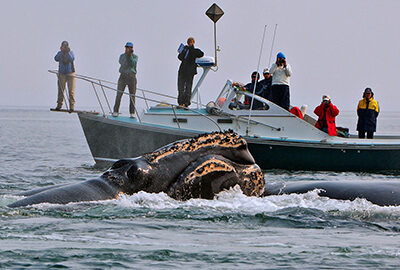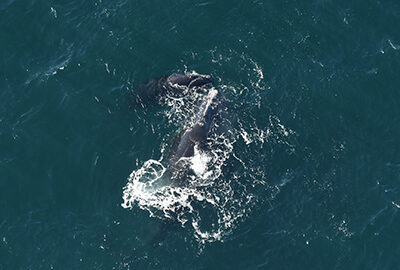Construction Update: As we enhance the look and feel of the Aquarium and make structural improvements to the penguin exhibit, some exhibits are temporarily closed, and the penguins are off exhibit until February 13. Learn more.
The Trust Family Foundation Shark and Ray Touch Tank will be closed from January 5 to January 6.
The North Atlantic right whale is one of the rarest whale species in the world. With fewer than 390 individuals remaining, our researchers are working tirelessly to study and protect this critically endangered species.
General
Right whales are relatively slow-moving, spend much of their lives close to shore, and spend a good amount of time at the surface feeding and caring for their calves. Historically, whalers found them easy to find, catch, and tow in. Also, their thick blubber and baleen plates made them profitable, which made right whales the “right whales” to hunt.
Right whales are primarily found within 50 miles of the east coasts of the United States and Canada and range from Florida to Canada’s Gulf of St. Lawrence, with sporadic sightings near Iceland and Greenland and rare sightings in the eastern North Atlantic.
Many right whales remain on the northern feeding grounds year-round, but pregnant females and some others head south for the winter to the shallow coastal waters off Florida and Georgia in the southeastern United States to give birth. They spend the spring, summer, and early fall months feeding and nursing their calves in the waters of New England and Canada’s Gulf of St. Lawrence and Bay of Fundy before calves are weaned when they are about one year old.
Many right whales remain on the northern feeding grounds year-round, but pregnant females and some others head south for the winter to the shallow coastal waters off Florida and Georgia in the southeastern United States to give birth. They spend the summer and early fall months feeding and nursing their calves in the waters of New England and Canada’s Gulf of St. Lawrence and Bay of Fundy.
Our scientists primarily differentiate between individual whales by natural markings of cornified tissue, called callosities, on top of their heads. Each whale has a unique callosity pattern, just as humans have unique fingerprints. Another identifier can be injuries from human activities—entanglement and vessel strikes create scars that can last the whales’ entire lives.
Callosities are areas of raised, hardened tissue found on top of the right whale’s head, behind their blowholes, above their eyes, on their lips and along their chins. Callosities are inhabited by small amphipods called cyamids—also known as whale lice—which feed off the dead skin of the whale! Most cyamids are white in color and are helpful for photo-identification as the callosity appears light-colored from a distance in contrast to the whale’s black skin.
Right whales eat zooplankton called copepods, small animals about the size of a grain of rice.
Right whales are one of 14 species of baleen whales, which also includes grey whales and humpback whales. Comprised of keratin—the same material that makes up our hair and fingernails—baleen hangs from a whale’s upper jaw with about 200 long, narrow plates on each side. In right whales, these plates can be over six feet long.
All baleen whales have baleen plates in their mouths instead of teeth and use their baleen to strain food from the water. Right whales are filter feeders—they swim with their mouths wide open through a dense patch of copepods. The prey gets trapped on the matted hair-like fringe of the inner edge of the baleen plates, and the water streams out between the plates. Feeding with their mouths open makes them vulnerable to entanglements in their mouth and baleen.
To get enough copepods to make eating worth the energy it takes to swim with their massive mouths open—a process known as skim feeding—right whales need to find super-dense patches of copepods. Some of these patches can contain more than 300,000 copepods per cubic meter. It’s estimated that a right whale can eat as much as a billion copepods per day—that’s one to two tons!
Keep your distance. Federal laws prohibit approaching whales closer than 500 yards.
Please report all right whale sightings from Virginia to Maine to 866-755-6622 and from Florida to North Carolina to 877-WHALE-HELP.
Right whale sightings in any location may also be reported to the U.S. Coast Guard via Channel 16 or the WhaleAlert iPhone/iPad app.
There are two other species of right whales—southern right whales and North Pacific right whales.
The three species of right whales do not overlap spatially. Southern right whales live throughout the Southern Ocean and are found off the coasts of Africa, South America, Australia, and New Zealand.
North Pacific right whales are found in offshore waters of the Bering Sea, the Gulf of Alaska, and off the coast of Japan.
The southern right whale population has recovered well from the whaling era. Southern right whale populations have grown at a rate of six to seven percent per year and number more than 10,000 individuals. There is much lower exposure of this species to human activities compared to North Atlantic right whales, which has allowed for a strong recovery.
The North Pacific right whales are not well studied, but photo-id data suggest the population may be less than 100 individuals. They were heavily hunted through the 1960s by illegal whaling efforts.
Pregnancy and Calving
A healthy whale can give birth to a single calf every three to six years.
The number of calves documented each year has ranged from a high of 39 in 2009 to a low of zero in 2018.
Overall calf production for this species is considered sluggish compared to their southern right whale cousins. Calf production has been notably lower than typically seen during two periods: in the 1990s and since 2017. Over the past forty years, scientists have determined that females are not growing as big, and this, in turn, is reducing calf production. The reasons for this stunted growth are related to human impacts and shifting food resources.
Many reproductive female right whales have experienced entanglements, which Anderson Cabot Center scientists have shown can lead to reduced health and, in turn, reduced reproduction. Additionally, females need a certain level of fat to achieve pregnancy, and climate change has caused food resources to shift in both distribution and quality, potentially making it more difficult for right whales to find adequate food and replenish their body fat.
2018 is the first year since surveys began in 1980 that no calves were documented, and in 2017, only five calves were born. Combined with these low calf counts, there has been an increase in the severity of the wounds caused by entanglements and a broad-scale shift in whale distribution. Neither of these other problems was evident during previous reproductive declines. This highlights the need to implement broad-based measures to reduce human impacts to right whales.
The species does have relatively low genetic diversity, but what impact that has on the population is unknown. Some populations of other mammals have flourished despite low genetic diversity.
Entanglement
Entanglement refers to the wrapping of ropes or netting around the body of an animal. When the strong lines—like those running from buoys on the ocean’s surface to lobster or crab pots below—get caught in a whale’s mouth or wrap around its flippers or fluke, they can cut into the skin and restrict movement.
Entanglement in fishing gear can cause significant injuries to whales, with the ropes slicing into flesh and bone and causing infections, injuries, or partial amputations that directly impact the whales’ ability to feed and swim. If the ropes prevent the whale from coming up to the surface to breathe, it may die quickly. Other whales who survive the initial entanglements may be badly wrapped in the gear and drag long lengths of ropes for months, gradually losing weight until dying by starvation.
While the proportion of the observed population entangled each year hasn’t risen, the severity of entanglements has increased. As ropes have gotten stronger, right whales have a harder time freeing themselves from gear.
Most entanglement mortalities are not detected as these whales either drown at depth or slowly starve and sink after death. Annual assessments of serious injury and mortality indicate at least 10 right whales per year since 2010 are dying from entanglement.
Right whales are sometimes called the “urban whale” because so much of their habitat overlaps with human activities, including fishing. Research by the New England Aquarium has shown that over 85% of all cataloged right whales have been entangled in fishing gear at least once, and some as many as nine times. Right whales are also vulnerable because of the way they feed with their mouths open for long periods of time, filtering zooplankton. Most right whale entanglements originate at the mouth.
Two metrics are used to evaluate entanglement impacts: the complexity of the entangling gear on the whale and the severity of injuries resulting from the entanglement. If an entanglement results in constricting wraps around a body area or there is a lot of trailing gear, these cases are more likely to lead to death. If the injuries to the whale are severe and deep, even if rope is no longer attached, the whale will still likely die.
Wherever fishing gear and whales overlap, there is a risk of entanglement. Entanglements occur throughout the right whales’ range and have been documented in waters off the southeastern U.S. coast, Mid-Atlantic, southern New England, the Gulf of Maine, and the Gulf of St. Lawrence.
Most commonly, whales get entangled in pot and gillnet gear, specifically the rope/line that is used to connect the traps or nets at the bottom of the ocean with a buoy at the water’s surface. Pot gear is used to catch lobsters, crabs, and hagfish. Gillnets are used to catch a variety of fish species. For North Atlantic right whales, lobster and snow crab gear pose the greatest risk when it comes to entanglement.
Yes. Even successfully disentangled whales can be impacted for years, and some do not survive. Any entanglement would be stressful for a whale—through work with fecal and blow samples, scientists at the Anderson Cabot Center found entanglements cause “sky-high” stress hormone levels—but depending on the type and weight of the gear and the entanglement configuration, severe injuries can also occur and can cause lasting effects even if the whale is disentangled.
Entanglement can lead to compromised health, which affects survival and reproduction. Whales that experience severe entanglements are eight times more likely to die than a whale that suffers a minor entanglement injury.
Right whales need to be healthy to have calves, and entanglement injuries have prevented whales from building sufficient fat reserves and breeding the way they have in the past. For male whales, an entanglement handicap can mean they aren’t fit enough to mate. For females, entanglement injuries—and their aftermath—are lengthening the intervals between calving from every three to six years to about 10 years.
For some whales, it’s obvious: The entangling gear remains attached. For whales that have freed themselves or were freed by rescuers, their brush with fishing gear leaves scars on their bodies. Entanglement scars, where the ropes rubbed along the skin or cut into the flesh, are often found near the peduncle (tail), mouth/rostrum area, and flippers.
Federal laws prohibit approaching whales closer than 500 yards unless you have a specialized permit allowing a closer approach for research or disentanglement.
If you see an entangled whale, call the entangled whale hotline—1-866-755-6622— or call the Coast Guard and provide information to responding parties. If at all possible, keep the entangled whale in sight until help arrives.
Some right whales have shifted into the Gulf of St. Lawrence in recent years, and, as a result, there has been an increase in entanglements there, especially in snow crab gear. Despite efforts by Canada to conduct increased surveillance and implement fishing closures when right whales are seen, unfortunately, entanglements are still being documented in Canadian gear. We know that entanglements occur throughout the coastal waters of the United States and Canada, so Anderson Cabot Center scientists advocate for implementing whale release ropes and on-demand gear on a broad scale instead of dynamically only when right whales are observed.
/
Vessel Strikes
Collisions with fast-moving large ships are almost always lethal, but even small vessels can seriously injure or kill right whales. This is one of the reasons federal law prohibits approaching whales closer than 500 yards.
For more information about ship-strike reduction regulations, please visit nmfs.noaa.gov/pr/shipstrike.
It’s possible that right whales don’t hear the ships because the ocean is noisy, and they can’t avoid them until it’s too late. Also, their migration takes them all along the US East Coast and up into Canada—a highly urbanized section of the ocean. Right whales may be near ships so often they ignore them a large part of the time, only recognizing them as a threat when it’s too late. Additionally, there’s some evidence that the bows of large ships mask the sound from the engine—a phenomenon called the “bow null effect”—which could make it difficult for whales to hear vessels approaching.
The technology does not exist for long-term tags that don’t harm the whales. Scientists have tried to tag right whales with unintrusive tags that stick on the whale’s skin and subcutaneous tags that are embedded into whale blubber and sometimes muscle. The tags that stick to the skin do not stay on the whale for long, and the longevity of even the invasive tags is typically only days to weeks, so they cannot be used to notify maritime users of where every right whale is.
Tags embedded into the blubber and muscle show clear damage to the individual whales; some tagged whales had regional and local swelling at the tag site that lasted for years. A study showed tagged blue whales skipped reproduction, and a southern resident killer whale died as a result of tagging. These are risks we cannot take in the North Atlantic right whale population.
Science and Research
Although entanglements and vessel strikes are the biggest threats to North Atlantic right whales, they also suffer due to chemical and noise pollution, degrading habitats, declining prey, and climate change. To help combat these threats, scientists conduct a variety of research to help regulators inform management decisions that will help the right whales recover.
Underwater noise pollution—from ships, energy infrastructure, and offshore oil and gas surveys—increases the stress hormones in right whales, interrupting their normal behavior and interfering with their communication.
Understanding right whale health and its implications for both individuals and the population is important to the conservation of the species. Because right whales are large, free-swimming whales, it can be challenging to assess their health. However, over the years, whale scientists, including researchers at the New England Aquarium, have developed several ways to do so. Biopsy, fecal, and hormone samples, as well as Visual Health Assessments, are all used to inform our understanding of right whale health.
When a whale defecates or exhales at the surface, those biological “waste” products of feces (poop) or blow (respiratory fluids) can offer us a window into the internal health of a whale. Scientists at the Anderson Cabot Center have pioneered the use of fecal and blow samples to examine hormone levels in right whales—an important indicator of health, stress, and reproductive status. By establishing an understanding of baseline hormone levels in healthy whales, scientists can evaluate and monitor whales that are under stress, including those who are entangled or who have been injured from a vessel strike.
Baleen from a dead whale can also give scientists access to valuable data on hormones that were deposited in the hair-like baleen as it grew during a whale’s life. Like reading an ice core, a single baleen plate can provide a timeline on the animal’s health while it was alive and whether it had any pregnancies in the last 10 years.
Biological samples are challenging to obtain from an animal that is huge, deep-diving, and fast-swimming. Nonetheless, scientists at the Anderson Cabot Center use and develop a few different approaches to gain important samples from whales.
Firstly, poop from right whales is distinctive – it looks like bright orange blobs and often floats at the surface due to the whales’ diet of oily copepods. Scientists at the Anderson Cabot Center have been scooping poop for over two decades!
Another novel technique is whale blow collection. As air-breathing mammals, whales must come to the water’s surface to exhale and take in fresh oxygen. This forceful expulsion of gasses from enormous lungs provides an opportunity to collect a sample of respiratory fluids, aka blow or snot. Like poop sampling, blow can be collected without touching the whale by using either a long pole or drone to suspend a petri dish above the exhaling blowholes.
To biopsy a whale, an arrow with a specialized tip that collects a small plug of blubber and skin is shot at the whale’s body using a crossbow. Even though it sounds invasive, the size of the biopsy tip versus the size of the whale makes this akin to a mosquito bite in humans. The vast majority of whales display little or no reaction to this, and the spot heals over quickly. The scientific gains from this endeavor, however, are enormous.
Scientists at Saint Mary’s University in Halifax, Nova Scotia, genetically analyze these samples and are able to identify the whale, determine its sex, potentially find out who the father is (if he’s in the database and the mother is known), and determine relatedness to other whales. So far, more than 80% of the population has been sampled.
Genetic information helps scientists identify a dead animal through skin or bone samples collected from a carcass that has lost the usual external marks that allow us to photographically identify it. Genetic information has also helped scientists estimate the original size of the right whale population before commercial hunting and even tell them how few calving females there were at the population’s lowest point.
The Visual Health Assessment method was developed in 2000 as a means to non-invasively assess right whale health using photographs routinely taken for photo-identification purposes. The assessment is based on the evaluation of four parameters that can be examined using shipboard and/or aerial images: body condition, skin condition, marks forward of the blowholes, and cyamids around the blowholes. These parameters were chosen based on visible changes seen in whales that are known to be in poor health (e.g., chronic entanglement cases). Analyses of visual health assessment data have allowed us to clarify links between health, reproduction, anthropogenic impacts (fishing gear entanglements, vessel strikes), and survival. Additionally, the method can be applied to evaluate not only the present health condition of injured whales but also describe changes in condition post-injury, making it a useful tool to inform better annual injury determinations and estimates of human impact on this species.
Sea surface temperatures in the Gulf of Maine, a key right whale habitat, are warming 99% faster than sea surface temperatures in any other part of the world. There’s evidence that the distribution of right whales’ food source—copepods—is shifting as surface temperatures warm. Scientists have also seen a drop in the nutritive value of copepods in previously rich feeding grounds.
Climate change may well be contributing to the reduction in births in this population and perhaps in individual whale survival. But we know entanglements are definitely causing mortality and decreased health. If we can remove or reduce the harm from entanglement, these long-lived animals may be able to adapt to the shifting climate.
We have seen evidence that the right whales are adapting to shifting food distributions as they have moved away from the Bay of Fundy and into the Gulf of St. Lawrence, where the food resource is now more substantial.
Whale release ropes are reduced-breaking-strength ropes or ropes with inserted weak points that would break when the whale exerts enough force. While these ropes will not prevent entanglement, they would help avoid complex and potentially lethal entanglement and reduce the number of life-threatening entanglements for large whales by at least 72% while still providing sufficient strength to withstand the routine forces involved in many fishing operations.
Scientists at the Anderson Cabot Center studied the breaking strength of ropes retrieved from entangled whales. Smaller species, such as minke whales and young right whales up to two years old, were found in significantly lower breaking strength ropes than the bigger species and adult right whales. As a result of this study, a recommendation was put forward for the broad adoption of ropes with a maximum strength of 1,700 pound-force, at least half the strength of ropes presently in use.
Recently implemented regulatory measures in the US require using 1,700-pound-force ropes in trap and gillnet gear. Different types of ropes and weak links have been approved for use by NOAA, and requirements vary for how much of the endline needs to be weaker. Our role is to monitor right whale and other large whale entanglements to determine if there is a reduction in the frequency and severity of entanglements as measures ideally continue to be strengthened in the U.S. and Canada.
There are three types of on-demand gear actively being tested with fishers: pop-up buoy, inflatable lift bag, and buoyant spool. Each of these setups ensures that there is no end line in the water column until an acoustic release signal is sent by the fisherman when in proximity to the gear. Testing is happening in both U.S. and Canadian waters and, if implemented broadly, could eliminate many preventable entanglements of right whales and other marine species.
Another technique would use CO₂ cartridges that, in response to an acoustic signal, would inflate a bag that would float the trap to the surface. Another technique uses a spool that is tethered to a weight that is then attached to a string of traps. When a signal is sent from the boat, the spool is released, uncoiling the rope as it ascends to the surface.
Saving the Species
Whales play a vital part in the marine ecosystems in which they live. Whales often feed on zooplankton at depth and then poop at the surface, which is incredibly important to nutrient cycling and delivery in ocean systems. Whale falls—when a dead whale’s body sinks to the ocean floor—also provide tremendous energy into deep-sea communities.
In 1980, a New England Aquarium research team unexpectedly discovered 25 North Atlantic right whales in the Bay of Fundy. Before that, scientists believed the right whale was nearly extinct. From 1990 to 2010, the right whale population grew steadily, and scientists believe it can again. North Atlantic right whales are a resilient species. They are long-lived and have prolonged reproductive capabilities.
If we give them some immediate relief from extrinsic pressures—fishing, pollution, vessel strikes—we believe they can recover.
From seasonal fishing area closures when right whales are in the area to regulating vessel speeds and routes, there are a number of management measures in place to help protect the endangered right whales. However, since 2010, as right whale distribution has shifted and human impacts on the species have worsened, prompting the designation of an Unusual Mortality Event in 2017, both the U.S. and Canadian government agencies are aiming to expand management measures. These much-needed measures have unfortunately been hampered for a variety of reasons, but Anderson Cabot Center scientists and policy experts are continuing to advocate for the implementation of stronger measures.
One inspiring success story occurred in 2003. Working with government, industry, and environmental stakeholders, Aquarium scientists successfully advocated for a change in shipping lanes in the Bay of Fundy to help protect migrating right whales from ship strikes. In doing so, the risk of right whales suffering a ship strike in this region dropped by about 80%.
In 2008, the federal government also enacted a ship-speed rule slowing down ships 65 feet or longer to speeds of 10 knots or less in specific areas during specific times of the year (Seasonal Management Areas). This rule has been very effective in reducing the likelihood of a fatal vessel strike.
With the increased focus on the right whale species and its dire situation has come a resounding public call of “What can we do?” Scientists, engineers, fishers, shipping companies, and management agencies are moving with urgency to research, test, and implement measures that will reduce right whale mortalities and serious injuries. But what can the general public do? Here are a few suggestions:
- Be aware of the situation right whales are facing and educate others. People need to understand what little time we have to save this species.
- Support local fishers and organizations working to change fishing practices to make their gear whale-safe, such as the Pioneers for a Thoughtful Coexistence in Massachusetts.
- Tell your local, state, and federal representatives that you encourage and support policies designed to protect right whales. Vote for candidates who support ocean conservation.
- Support organizations working to improve policies to reduce human impacts on right whales.
- Advocate for bans on single-use plastic bags and Mylar balloons. These items are often seen in right whale feeding areas. Plastics of all types can end up in the ocean and lead to major problems for whales (and other marine animals) if ingested.
- Boaters should be aware of when whales are in their waters and slow down to 10 knots or less to reduce the risk of vessel strikes. Even small vessels can seriously injure or kill right whales.
- Before buying seafood at a market or restaurant, ask where it comes from and what that fishery is doing to prevent whale entanglements and deaths. Most sellers will have no idea, but if you ask the question, they will know it’s important to their customers. And that takes us back to our first suggestion: Educate others! We hope to get suppliers to support the idea of only buying from fishers who use gear that’s safe for whales, so your question may spark conversations between suppliers and fishers.
We are at a critical crossroads for the North Atlantic right whale population. We know the species is resilient and can bounce back from the events that have unfolded over the last few years. But, for right whales to be able to do so, we have to minimize or eliminate severe human-caused injury and mortality now.

